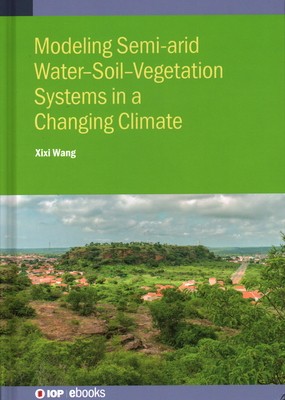
- We will send in 10–14 business days.
- Author: XIXI Wang
- Publisher: IOP Publishing Ltd
- ISBN-10: 0750340185
- ISBN-13: 9780750340182
- Format: 17.8 x 25.4 x 2.2 cm, hardcover
- Language: English
- SAVE -10% with code: EXTRA
Reviews
Description
Water-soil-vegetation dynamic nexuses affect, and are affected by, both human activity and climate change. For a given area, inappropriate land management practices can result in soil and vegetation degradation, which in turn will likely alter natural hydrologic processes, leading to more frequent and severe flooding and drought. In response, an altered hydrologic condition tends to prompt soil erosion by wind and water, which can cause further vegetation degradation or even loss. Such nexuses will likely become more interwoven in changing climate because the non-stationary climate can further deteriorate the already-altered hydrologic condition. So far, our understanding is incomplete regarding how such nexuses maintain or break equilibriums between water, soil, and/or vegetation in terms of eco-environmental resilience. This book: 1) conceptualises the interrelated physical processes of water-soil-vegetation systems; 2) introduces mathematical models for simulating the processes; and 3) develops a variety of modelling cases of selected systems across the world.
Currently, there are no books focusing on this topic though some incomplete information has been scattered in various peer-reviewed journals and project reports. This book provides a systematic elucidation of this important topic and serves as a one-stop information source. Upon reading this book, the reader can apply the materials to conduct advanced research on this topic and develop practical measures in protecting fragile vegetation ecosystems and confronting climate change. The broader application is to prevent land degradation and desertification as induced by climate change and human activities (e.g., development and grazing).
Recommended for researchers and graduate students.
Key Features:
- Includes both fundamental principles and practical applications
- Emphasizes semiarid water-soil-vegetation nexuses rather than individual processes
- Deciphers dynamics and interrelations of the physical processes of semiarid water-soil-vegetation systems
- Addresses impacts of climate change from practical management perspectives
- Maximizes readability by including illustrations, pictures, and annotated equations.
EXTRA 10 % discount with code: EXTRA
The promotion ends in 20d.17:35:26
The discount code is valid when purchasing from 10 €. Discounts do not stack.
- Author: XIXI Wang
- Publisher: IOP Publishing Ltd
- ISBN-10: 0750340185
- ISBN-13: 9780750340182
- Format: 17.8 x 25.4 x 2.2 cm, hardcover
- Language: English English
Water-soil-vegetation dynamic nexuses affect, and are affected by, both human activity and climate change. For a given area, inappropriate land management practices can result in soil and vegetation degradation, which in turn will likely alter natural hydrologic processes, leading to more frequent and severe flooding and drought. In response, an altered hydrologic condition tends to prompt soil erosion by wind and water, which can cause further vegetation degradation or even loss. Such nexuses will likely become more interwoven in changing climate because the non-stationary climate can further deteriorate the already-altered hydrologic condition. So far, our understanding is incomplete regarding how such nexuses maintain or break equilibriums between water, soil, and/or vegetation in terms of eco-environmental resilience. This book: 1) conceptualises the interrelated physical processes of water-soil-vegetation systems; 2) introduces mathematical models for simulating the processes; and 3) develops a variety of modelling cases of selected systems across the world.
Currently, there are no books focusing on this topic though some incomplete information has been scattered in various peer-reviewed journals and project reports. This book provides a systematic elucidation of this important topic and serves as a one-stop information source. Upon reading this book, the reader can apply the materials to conduct advanced research on this topic and develop practical measures in protecting fragile vegetation ecosystems and confronting climate change. The broader application is to prevent land degradation and desertification as induced by climate change and human activities (e.g., development and grazing).
Recommended for researchers and graduate students.
Key Features:
- Includes both fundamental principles and practical applications
- Emphasizes semiarid water-soil-vegetation nexuses rather than individual processes
- Deciphers dynamics and interrelations of the physical processes of semiarid water-soil-vegetation systems
- Addresses impacts of climate change from practical management perspectives
- Maximizes readability by including illustrations, pictures, and annotated equations.


Reviews